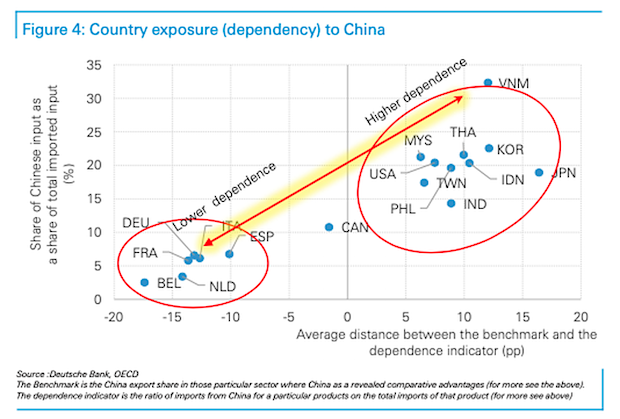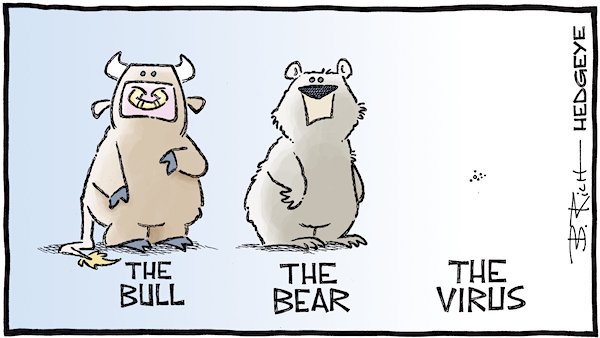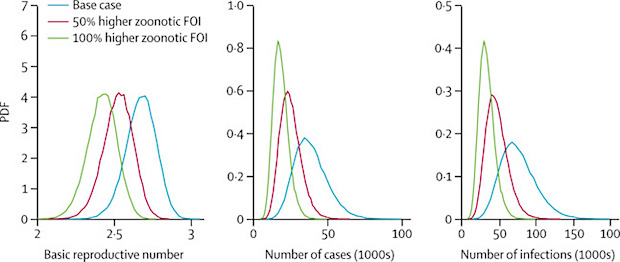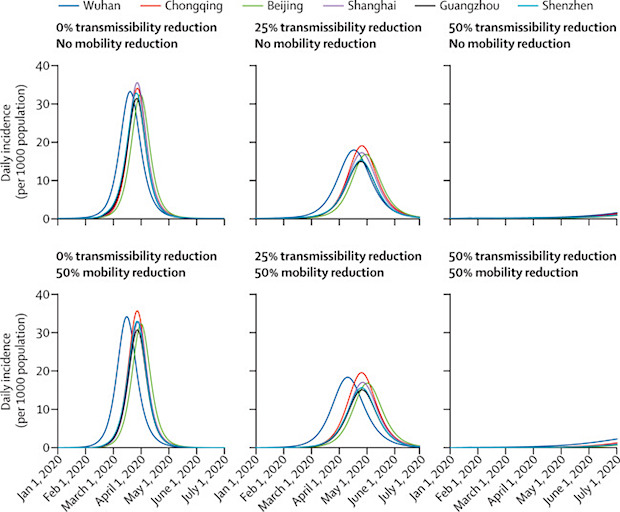
Venice carnival or Black Death? Mary Poppins?

Many of the things we see happening now with the coronavirus, COVID-19, SARS-CoV-2, take your pick, I “predicted” a while ago. But I’m not in the predicting business, and anyone who would have said even just a week ago that Italy would have 11 deaths today and/or Iran would have 50, or the US 53+ cases of infection, would have been labeled a raving lunatic.
Wuhan apparently relaxed some of their lockdown measures yesterday (and walked that back hours later), as did other places in China when they hadn’t had any new cases for 24 hours or so, and we know why they do it -it’s the economy, stupid!- but that is really the worst possible thing to do. China’s even trying to telegraph that they are in control again, as per Zero Hedge:
“As the WHO team wrapped up its Monday press conference with what was essentially tantamount to a global confidence-building exercise in China’s response, a senior official from China’s National Health Commission said the coronavirus risk from Wuhan had gone ‘way down.’ Of course, if that’s true, then why did officials cancel a planned easing of the lockdown? The official added that China has “..managed to stop the ‘rapid rise’ of infections in Wuhan, though they haven’t stopped the epidemic yet..”
Of course it’s lovely that at the very moment China – falsely- claims to be regaining control, markets worldwide sink into a deep well and gold climbs the Kilimanjaro. Surprising it is not. It simply shows that “investors” are mostly completely clueless about the virus, and the media they follow mostly don’t know dick all either or prefer not to rock the cradle.
The so-called investors follow the same behavioral pattern that civil servants, politicians, “management” at companies, and journalists do. They check first and last what others are doing, so they won’t look out of tune and they can’t be accused of crying wolf. They tend to only act when the rest do, and by then it will inevitably be too late. Man as a social animal, covering their asses by hiding behind others.
For those so-called investors, who cares what they do or why? But for politicians and civil servants, this mindset means they will NOT be ordering test-kits, medicine and the like, when they should. And not warning the public about various upcoming threats and shortages.
For journalists it means their readers and viewers are only clued in when the wolf’s right on their doorstep. I’ve used the Chinese politburo as an example in The Party and the Virus (Feb 2), but I don’t think western countries are much, if any, faster or wiser or more aware. These are all jobs replete with born followers who have only ever learned how to hide behind mom’s skirts and aprons.
And for the rare few who don’t think in herd terms, they will be ridiculed by the sheep in that herd, who will again seek strength in numbers and behind aprons when they are found wanting. Which is fine for investors, they are only playing with money. The others, though, are playing with human lives.
A comment on my article last week, Go Forth and Multiply (Feb 20), suggested that I merely collected the most alarmist articles and turned them into an article. Nope.
The article deals with the failures of all the groups of people mentioned above, in various countries, which have led to where we are today. There are plenty other reports which are far more “alarmist”. I am not personally talking about worst-case scenarios, but in other instances I have quoted a few scientists who would fit that description. Take for instance Gabriel Leung at Hong Kong University, whom I’ve quoted more than once. Leung and his team contend:
• Most experts thought that each person infected would go on to transmit the virus to around 2.5 other people. That gave an “attack rate” of 60-80%.
• Even if the general fatality rate is as low as 1%, which Leung thinks is possible once milder cases are taken into account, the death toll would be massive.
• “Is 60 to 80% of the world’s population going to get infected? Maybe not. Maybe this will come in waves. Maybe the virus is going to attenuate its lethality because it certainly doesn’t help it if it kills everybody in its path, because it will get killed as well..”
There’s Harvard epidemiologist Marc Lipsitch, who predicts that “within the coming year, some 40 to 70 percent of people around the world will be infected..” And Lancaster University epidemiologist/biostatistician Jonathan Read isn’t all that much cheerier.
Compared to those guys, I am not an alarmist, nor do I go out to look for articles in that vein. I did see quite a while ago that this virus had “potential”, though. And I did see The Big Lockdown (Feb 5) coming before it did. Actually, I see a lot more of that. My intent is to go back to Athens in April, but I seriously have no idea if that will be on offer 5-6 weeks from now, as Italy already today has 11 deaths, 322 cases, and over 100,000 people under lockdown, and deployed the military. Italy had nothing a week ago. And Italy is not that far from Greece.
Come to think of it, nor is it from Holland, where I am right now. That is a situation that people should have woken up to a long time ago. Holland has a number of its citizens locked up in a hotel on Tenerife, Canary Islands, a Spanish province off the northwest coast of Africa. There are 1000 guests in the hotel, all confined to their rooms, because one guest was an Italian who tested positive for COVID19.
There’s also a hotel in Innsbruck, Tyrol, Austria on lockdown. It has an Italian receptionist who is infected. Check the quarantine time for theose people. If it’s less than two weeks, you know nobody’s learned a thing.
This is the shape of things to come. As is Italy admitting a hospital actually spread the virus. And Japan saying it will now attempt to limit virus deaths, instead of preventing them. That may sound like mere semantics, but it’s not. It sounds like Japan giving up on the 2020 Tokyo Olympics without pronouncing it.
Also in Holland, yesterday a high end webshop, which sells electronics, including iPhones, etc., said they want to sell less!! and will raise prices because they foresee they can’t get sufficient supplies from China anymore soon. The obvious media reaction is they must be crazy, because competitors haven’t done the same. But that’s too easy. Maybe they just broke free of the mold of waiting for others to act.
What I find interesting in that light is that Holland’s dependence on the global China trade is much less than for other rich nations, and for south east Asia as a whole. Whither Amazon, Walmart, whither the Silk Road? Quo Vadis?

On February 6, the day after I published The Big Lockdown , a friend at the Global Change Research Institute, reacting to my question “Will [the Chinese] have an economy left by then?” (I don’t remember the exact time I referred to), said “Isn’t that TOO pessimistic?”
My reply was: “There’ll always be something left. There was an economy 100 years ago, and 500, and 1,000. It started when Eve made a deal with a snake. My point was more: what KIND of economy will there be? Nobody seriously considers a collapse such as this, and I think they should.”
He retorted: “I am not really convinced this will be a trigger of (chinese) economic collapse, but well, I am open-minded about such possibility… For now, I am corona-triggered-collapse-skeptic. ;-)”
I wonder how he feels about it today.
Me, I don’t think the biggest issue with the virus is the number of deaths and cases, at least not in the short term. The biggest issue is that there is a virus on the loose than has proven it CAN be lethal, and for which there is no vaccine.
The biggest issue is that we are stumbling woefully unprepared into the future, and therefore our only defense is to lock each other, and ourselves, up in our homes, (and our communities and cities if we’re lucky) until we can’t, social animals that we are.
The biggest issue will not be the cases or even deaths, it will be that ever more of the things we have come to rely on far away lands for, will slowly cease to arrive on our shores. Some of it will be trinkets we never needed, but some of it will also be things without which our lives and communities can no longer function the way we’re used to.
It will be a slow process. Or will it, nothing really moves slow with this virus; it appears to move in virus time, not human time.
You should probably get some immune system boosters while they are available, like Vit.D(3) and echinacea. Facial masks perhaps, while there are any. There are professionals who are regular commenters on the Automatic Earth and who can answer questions on that.
We should also likely prepare for a large-scale reduction in large-scale activities, events that require crowds. Olympics, sports games, concerts, arenas, but also supermarkets and department stores. And then after that come public transport and factories. Alarmist again? Just wait till the first case or death comes to a town near you. Observe how people react. You can see it today in Wuhan, Beijing, Milan, Qom.
By the way, how do you know there are no cases near you? Is anyone testing? Do they have test kits? They will test soon, and they will have kits if they can find any. Note: Japan said today their supply of test kits will be used only for the most serious cases. Everyone else is on their own.
New reports of infections are coming in today from Canada, Bahrain, Croatia, Austria, Switzerland, Romania, Barcelona and more. Ask yourself: what are the odds this will stop tomorrow morning? Or that the US won’t get worse? Face masks, Vit. C, Vit.D(3), echinacea and other things won’t bankrupt most of you, and they’re good for you anyway, so maybe get them while you can.
Oh, and prepare for an enormous amount of misinformation emanating from the politicians and media who are always way behind the curve, and who right now are all actively pondering how to protect the economy. They can’t conceive of a world where a virus can trump the economy. Pun intended. Neither can those who call themselves “investors”. It’s the virus, stupid. HedgeEye got that one particulary well:

Me, I’m sitting here wondering what the link is between the masks for the -now cancelled- Venice carnival, and the Black Death. But that sounds at least a little alarmist, too, doesn’t it?
Please remind me to pick up a copy of Boccaccio’s Decameron(e), in which ten people tell ten stories each while in quarantine outside of Florence during the Plague, around 1350 AD. Should be popular soon.

If you read us, please support us. It’s the only way the Automatic Earth can survive. Donate on Paypal and Patreon.










